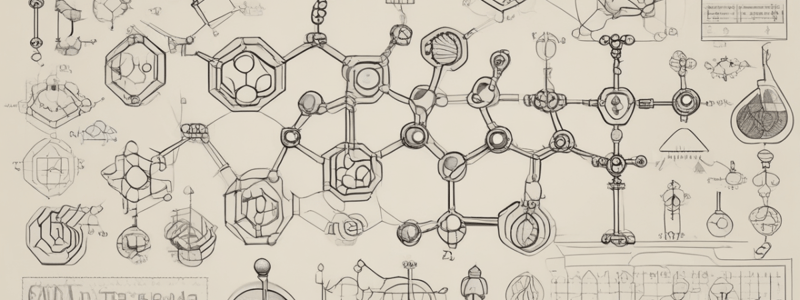Podcast
Questions and Answers
Match the functional groups with their general formulas:
Match the functional groups with their general formulas:
Alkyl = R- Hydroxyl = -OH Carbonyl = C=O Amino = -NH2
Match the functional groups with their polarity:
Match the functional groups with their polarity:
Hydroxyl = polar and hydrophilic Alkyl = non-polar and hydrophobic Carbonyl = polar and electrophilic Amino = basic and nucleophilic
Match the functional groups with their reactivity:
Match the functional groups with their reactivity:
Aldehydes = undergoes oxidation, reduction, and condensation reactions Ketones = undergoes oxidation, reduction, and condensation reactions Carboxylic Acids = undergoes neutralization, esterification, and oxidation reactions Ethers = stable, unreactive
Match the compounds with their functional groups:
Match the compounds with their functional groups:
Signup and view all the answers
Match the functional groups with their physical properties:
Match the functional groups with their physical properties:
Signup and view all the answers
Match the functional groups with their chemical properties:
Match the functional groups with their chemical properties:
Signup and view all the answers
Match the functional groups with their examples:
Match the functional groups with their examples:
Signup and view all the answers
Match the functional groups with their characteristics:
Match the functional groups with their characteristics:
Signup and view all the answers
Study Notes
Functional Groups
Alkyl (R-)
- A functional group consisting of a saturated hydrocarbon chain
- General formula: R-
- Examples: methyl (-CH3), ethyl (-C2H5), propyl (-C3H7)
Hydroxyl (-OH)
- A functional group consisting of a hydrogen bonded to an oxygen atom
- Found in alcohols and phenols
- Polarity: polar and hydrophilic
- Examples: methanol (CH3OH), ethanol (C2H5OH)
Carbonyl (C=O)
- A functional group consisting of a carbon-oxygen double bond
- Found in aldehydes, ketones, carboxylic acids, and esters
- Electronegativity: oxygen pulls electrons, making carbon slightly positive
- Examples: formaldehyde (HCHO), acetone (C3H6O)
Amino (-NH2)
- A functional group consisting of a nitrogen bonded to two hydrogen atoms
- Found in amines and amino acids
- Basicity: acts as a base, accepting protons
- Examples: methylamine (CH3NH2), aminoethane (C2H5NH2)
Alcohols (R-OH)
- A functional group consisting of a hydroxyl group bonded to a carbon atom
- Examples: methanol (CH3OH), ethanol (C2H5OH), glycerol (C3H8O3)
- Physical properties: boiling point increases with molecular weight
- Chemical properties: undergoes oxidation, esterification, and dehydration reactions
Ethers (R-O-R')
- A functional group consisting of an oxygen bonded to two carbon atoms
- Examples: diethyl ether (C2H5OC2H5), tetrahydrofuran (C4H8O)
- Physical properties: low boiling points, low polarity
- Chemical properties: stable, unreactive
Aldehydes (R-CHO)
- A functional group consisting of a carbonyl bonded to a hydrogen atom
- Examples: formaldehyde (HCHO), acetaldehyde (C2H4O)
- Physical properties: pungent odor, low boiling points
- Chemical properties: undergoes oxidation, reduction, and condensation reactions
Ketones (R-CO-R')
- A functional group consisting of a carbonyl bonded to two carbon atoms
- Examples: acetone (C3H6O), cyclohexanone (C6H10O)
- Physical properties: sweet or pungent odor, low boiling points
- Chemical properties: undergoes oxidation, reduction, and condensation reactions
Carboxylic Acids (R-COOH)
- A functional group consisting of a carbonyl bonded to a hydroxyl group
- Examples: formic acid (HCOOH), acetic acid (CH3COOH)
- Physical properties: sour taste, corrosive
- Chemical properties: undergoes neutralization, esterification, and oxidation reactions
Functional Groups
Alkyl (R-)
- A saturated hydrocarbon chain with a general formula of R-
- Examples include methyl (-CH3), ethyl (-C2H5), and propyl (-C3H7)
Hydroxyl (-OH)
- A hydrogen bonded to an oxygen atom, making it polar and hydrophilic
- Found in alcohols and phenols
- Examples include methanol (CH3OH) and ethanol (C2H5OH)
Carbonyl (C=O)
- A carbon-oxygen double bond, making carbon slightly positive due to oxygen's electronegativity
- Found in aldehydes, ketones, carboxylic acids, and esters
- Examples include formaldehyde (HCHO) and acetone (C3H6O)
Amino (-NH2)
- A nitrogen bonded to two hydrogen atoms, making it a base that accepts protons
- Found in amines and amino acids
- Examples include methylamine (CH3NH2) and aminoethane (C2H5NH2)
Alcohols (R-OH)
- A hydroxyl group bonded to a carbon atom, with boiling point increasing with molecular weight
- Examples include methanol (CH3OH), ethanol (C2H5OH), and glycerol (C3H8O3)
- Undergoes oxidation, esterification, and dehydration reactions
Ethers (R-O-R')
- An oxygen bonded to two carbon atoms, with low boiling points and low polarity
- Examples include diethyl ether (C2H5OC2H5) and tetrahydrofuran (C4H8O)
- Stable and unreactive
Aldehydes (R-CHO)
- A carbonyl bonded to a hydrogen atom, with pungent odor and low boiling points
- Examples include formaldehyde (HCHO) and acetaldehyde (C2H4O)
- Undergoes oxidation, reduction, and condensation reactions
Ketones (R-CO-R')
- A carbonyl bonded to two carbon atoms, with sweet or pungent odor and low boiling points
- Examples include acetone (C3H6O) and cyclohexanone (C6H10O)
- Undergoes oxidation, reduction, and condensation reactions
Carboxylic Acids (R-COOH)
- A carbonyl bonded to a hydroxyl group, with sour taste and corrosive properties
- Examples include formic acid (HCOOH) and acetic acid (CH3COOH)
- Undergoes neutralization, esterification, and oxidation reactions
Studying That Suits You
Use AI to generate personalized quizzes and flashcards to suit your learning preferences.
Description
This quiz covers the basics of functional groups in organic chemistry, including alkyl, hydroxyl, and carbonyl groups.




